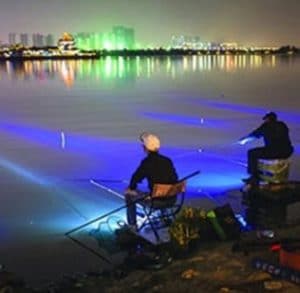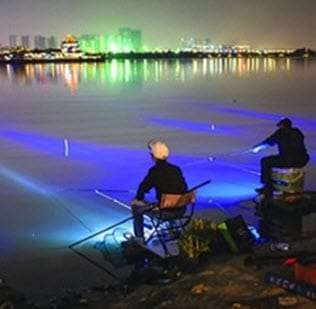
Watching my nephews (5 yrs old & 3 yrs old) discover new things is one of the really awesome joys of being an uncle. Remembering what it was like to have that unabashed sense of wonder and just find certain things so unbelievably interesting – even now as an adult that type of energy is infectious.
One thing my nephews absolutely went nuts over: discovering multi-colored flashlights. That happened a couple of months ago and they haven’t played with the lights on in their room since!
I’ve used red lens flashlights before and so was used to them, but as my nephews explored this strange new world of lights it did get me wondering: what exactly are blue lens flashlights used for?
The blue light from a blue lens flashlight is used widely to see at night without ruining night vision. Blue light is popular with fishermen because it can attract fish and cause some to glow reflectively to make them easier to see, while hunters can more easily track the blood of wounded animals. Outside of the outdoors blue light is used for spotting blood and fluids at crime scenes, for cutting through fog, and as a night alternative to red light or green light.
Blue light flashlights definitely are a favorite among many night anglers for both safety and practicality, and hunters who need to keep tracking a wounded animal into the evening hours.
Great – some of these activities apply to me – but I still wondered: how exactly does blue light work?
Table of Contents
The Science Behind Blue Light
Basically the human eye picks up different types of light in different ways. How well we see certain types of light is based around really scientific terms like “refraction,” “propagation,” or “reflective rates.”
Which is all a simple way to say that some types of light we see really well, some types we see well but at a cost of things like night vision, and other types of light we can’t see with the naked eye at all.
LED white light is bright but kills the night vision, for example. When it comes to blue light, the wavelength is shorter and interacts with the eye in a way that allows people to see in the dark without losing night vision while also lighting up certain fluids or natural biological stuff to create a fluorescent glow that sticks out.
Blue light is just one of those particular types of light that reveals interesting things to the human eyes.
The Power of a Blue Light
As mentioned already, there are plenty of outdoorsmen who love having a blue light on hand, and a blue light flashlight is definitely more convenient. For night fishing the use of blue light is two-fold: it makes it easier to see fish at night while making it safer on your boat (or on your on-shore setup) and in some situations it attracts certain types of fish, bringing them close to give you a shot to actually catch them.
Hunters will also appreciate the clear night vision that the blue flashlight provides, however blue light in particular is really good at making blood stick out. This is why hunters love it for tracking a wounded animal when it is getting dark and this is also why blue lights are a major part of crime scene investigation: because it makes blood and other fluids stick out that are otherwise invisible to the naked eye.
Blue light is also used with fog headlights because it is the only type of light that is easily seen by the human eye that also actually cuts through fog with minimum reflection back.
In some industries blue light is also the preferred light of choice when looking over equipment for safety inspection.
The are even perfect for astronomy buffs who want to take notes without ruining their night vision before looking back through the telescope once again!
Needless to say – this is a versatile light for both outdoor adventurers as well as useful for many other high stress professions!
Which is Better: Blue Light Flashlight or Red Light Flashlight?
This actually depends on what you are using it for. When it comes to pure ability to see in the dark without ruining night vision most people find relatively little difference between the two. In other words it’s basically a preference.
However, for certain needs or outdoor uses there are particular times where one might be a touch better than the other. It really is a situation based thing.
Choose a red light flashlight if:
- Night vision is your main concern
- Tactical use: seeing things close without giving away your position from a distance
Choose a blue light flashlight if:
- You may need to track blood
- Want a light that might attract fish at night
- You work in foggy conditions and need a better light
Best Blue Light Flashlight
There are a few good options out there when it comes to finding a quality blue light flashlight. Most options actually involve having a blue lens that can be attached to a tactical flashlight, thus putting the normal torch light through a blue filter.
While I always appreciate versatility, I also like just having a straight up blue light flashlight. In this case my favorite by far is the UltraFire blue flashlight. Lightweight, durable, and with surprising power behind the easy on the eyes blue beam, this is a case of where they really just got it right in design from A to Z.
This is even one of those well-built small tactical flashlights that is small enough to be an everyday carry item.
If you’re like me and want one of every color whether for yourself or the super excited nephews running around playing with their multi-colored flashlights from their new favorite uncle, then take a look at the Souyos 3-pack, which is also a pretty rock solid choice based on our first hand experience using them.
Our pick for best blue light flashlight on Amazon: UltraFire Blue Flashlight (click for up to date pricing)
Our pick for best pack of colored light flashlights: Souyos 3-pack Green, Red, White Flashlights
In Conclusion
Whether you prefer red light, blue light, or green light to keep the night vision intact it is mostly a matter of choice however for some specific instances blue light is clearly the way to go. Personally, I like having at least one lens or one flashlight of each. One red light, one green light, one normal LED light, and of course one blue light.
While I haven’t used the blue flashlight specifically for night fishing and see if all the stories about them attracting trout are true, it is a great night vision friendly option that I’m a huge fan of.
If yo’re looking for a night vision friendly flashlight for your nightly outdoor adventures, you can do a lot worse than going with a reliable blue light.

